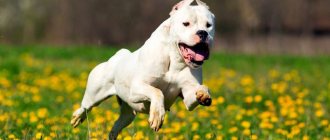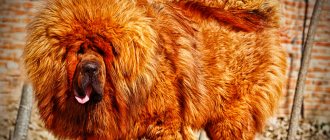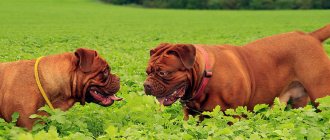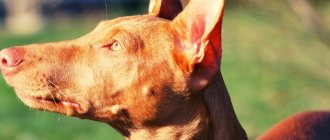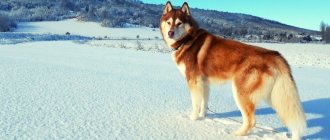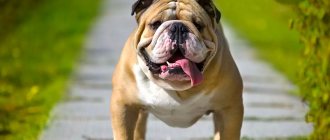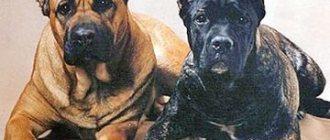The character of a dog depends on heredity and breed characteristics, but proper upbringing and training is also of no small importance. In this article we will tell you about the natural characteristics of the breed and how to properly start raising and training your pet.
The Dobermann is a large German dog breed with an athletic build. They were bred to serve as bodyguards, serve in the army and police, and in the right hands become companion dogs.
- Country of origin : Germany
- Height at withers : male: 68-72 cm; female: 63-68 cm
- Weight : male: 40-45 kg; female: 32-35 kg
- Lifespan : 12-15 years
- Use : Watchman, Security Guard, Companion Dog
- Other names : Doberman Pinscher, Thuringian Pinscher
Content
- The main character traits of a Doberman: female or male?
- Doberman character
- Basic commands
- Raising a dog
In this article you will learn what features of character and behavior are inherent in the Doberman. After studying this information about the temperament and disposition of a Doberman at different ages, you will get an idea about the breed. Find out how the character of a bitch differs from the behavior of a dog. We hope our article will help you figure out which gender of puppy is best for you.
The main character traits of a Doberman: female or male?
The Doberman puppy is an active and restless pet. If you take care of and train your puppy, you can avoid pampering. Constant damage to things does not indicate the baby’s bad character, he is just very active and needs somewhere to throw out his energy. You can buy toys for him, he will be active with them, direct his energy to playing with them. Already from 3-4 months (the time of socialization), he is able to perceive the general rules of education. At this time, it is important to begin socializing and training the dog.
Bitch: character
There is an opinion that Doberman females have a more submissive and gentle character. But experts believe that character largely depends on heredity and individual characteristics. There are always exceptions, bitches with a very difficult character, and there are males with an easy-going and submissive character. But still, there is a difference in the behavior of the sexes. There are advantages and disadvantages for female and male genders.
Advantages:
- Strong relationship with owner and home
- Emotionally sensitive perception
- Girls are smarter and smarter than boys
- Accepts training tasks well
- During walks, he runs less in the bushes
- Doesn't rush at strangers
- The breed is ideal for breeding, just one assessment from the exhibition is enough
Flaws:
- Sly
- Periodic menstruation
Physical differences
Boys
At first glance, males look very similar to females, but there are definitely some differences. These differences are more obvious in humans than in photographs. Males are on average about 5 cm taller and 5-10 kg heavier. So overall they are larger dogs. They also have more muscle mass, so they appear slightly larger with sharp body angles compared to women.
Girls
Female Dobermans are generally smaller in size than their male counterparts. Females have a sleeker appearance and some say they are more elegant.
Male: character
Advantages:
- High performance, very durable
- Solid appearance, a big plus for exhibitions
- Persistence in achieving results in the learning process
Flaws:
- Independent and more stubborn than a girl. Requires more strict training than a girl.
- To fulfill your physical and natural needs, you need a longer time for walks. According to physiology, he is not capable of quickly emptying the bladder.
- Can run away from its owner if it smells a female in heat.
- During the period of estrus in females, fights with other males are possible.
Is it possible to influence and correct the character of the Doberman?
Raising and training a Doberman is of great importance, as soon as you bring him into your home. Do not allow people to chew things, stop attempts to pester strangers while walking, do not allow them to eat from someone else’s hands, pick up food from the floor, or beg for food from you while eating. It is forbidden to jump on and bite people, even to show your love. Only training and proper upbringing will change a dog’s character for the better. The puppy training process is based on the method of motivation, encouragement and praise. It is prohibited and unacceptable to treat the dog harshly during training.
Care
The Doberman is an unpretentious pet. He lives well in an enclosure or in a house. Despite its overall dimensions, the dog does not require much space. If you walk him enough, he will be calm at home and will not misbehave or impose his company. Caring for an adult dog is also easy. Dobermans are distinguished by good health and unpretentious diet. They have short hair, no dog smell, and shedding is moderate.
You need to walk your dog at least 2-3 hours a day. In winter, you need to wear warm overalls, since Dobermans do not have an undercoat and do not tolerate cold well. If the dog lives outdoors, protection from the sun is necessary. And for the winter, the pet must be taken indoors.
Hygiene procedures are the same as for other short-haired dogs. It is necessary to periodically wipe it with a damp cloth and comb it with a stiff brush. After a walk, be sure to wash your pet’s paws and, if necessary, chest and belly. Full bathing is recommended several times a year.
Your pet's eyes and ears require care. They need to be wiped regularly and inspected for inflammation. Otitis often develops in uncropped ears. To prevent the formation of tartar, you need to brush your teeth regularly. It is especially important to monitor the condition of the puppies’ mouths, preventing inflammatory processes.
Nutrition
You need to carefully select food for your Doberman. There have been cases of gastric volvulus due to inappropriate feeding. Suitable nutrition will prevent overeating, but will be able to provide your pet with all the necessary substances. It is best to choose premium or super-premium complete dry food designed for large breeds. It could be:
- Purina® PRO PLAN;
- Royal Canin;
- Hill's;
Dry food should not be mixed with regular food. If the owner chooses natural food, meat should occupy the main place in it. You need to know how much of it an adult pet needs - at least 500 g per day. You should also give vegetables, cereals, fermented milk products, cottage cheese, and boneless fish.
Health
Doberman Pinschers are strong pets; when properly maintained, they live a long time and suffer little illness. Common pathologies of the breed are:
- elbow dysplasia;
- heart rhythm disturbance;
- narcolepsy;
- allergic diseases;
- musculoskeletal injuries.
To avoid illness, you need to regularly take your pet to the veterinarian. Before six months, the puppy must have all its vaccinations. Regularly treat your pet for fleas and ticks. And deworming 4 times a year.
To decide whether to get a dog of this breed, you can watch the video:
Doberman character
The Doberman is usually friendly and becomes very attached to its owner and his family members. Has moderate aggression and moderate excitability. The Doberman is a service dog, so it is necessary to take an obedience course and pay attention to the presence of a protective and fighting instinct, firmness and courage of character. Of particular importance for exhibition animals is self-confidence and courage while maintaining good contact with the owner.
Advantages of the breed
- wide range of applications. The breed is appropriate everywhere except lying in front of the TV. All types of service and security spectrum, any sports disciplines. Participation in social projects is possible (Dobermans are good guide dogs for the blind);
- loyalty to the owner. Brave Dobermans follow the leader through thick and thin;
- highest intelligence. Training and service are the best time in a Doberman's life;
- power and endurance. The Doberman is a real “fighting machine”: Hollywood exaggerates, but is not disingenuous.
How to raise a Doberman puppy
If you train your pet correctly, then over time you will get an obedient dog that will follow all commands and delight you every day. Experts believe that several factors may influence the Doberman's susceptibility to following various commands:
- pet's temperament - the speed of the pet's reaction to stimuli, both positive and negative;
- character - how exactly the dog resists various unpleasant influences;
- obedience - the dog’s ability to accept human leadership;
- vigilance - the speed with which the dog notices potential danger, both in relation to itself and in relation to the owner;
- aggressiveness - the pet’s ability to react hostilely to potential danger;
- curiosity - interest that is developed when a dog feels, hears and sees something;
- sociability - the ability to interact with people;
- possessiveness is the interest shown by animals in certain objects, for example toys.
How quickly your dog will learn commands depends on which traits predominate in the character of a Doberman puppy. By paying attention to the character traits of your animal, you can find an approach to it and adjust its behavior in certain situations.
- Eagerness will get you nowhere . You should not try to teach a Doberman puppy all the commands at the same time; you need to learn the commands one by one. You need to have patience and act methodically. You should not scold your pet at the moment when he makes mistakes, and when he succeeds in something, then the pet should be encouraged.
- Don't hit . It is prohibited to use physical punishment against a pet. You should limit yourself to variable intonation, but avoid shouting. After the Doberman puppy turns three months old, it is allowed to use a light spank as punishment while saying the phrase “Ugh.” It is necessary to punish immediately when the animal commits an offense, and not after it, since the animal simply will not understand what exactly it was punished for.
- Subsequence . The main goal is to ensure that the pet follows the command the first time. Commands should be pronounced clearly and in an even voice so that the dog understands and obeys you. All family members should be involved in raising the dog, but they must act together. It is forbidden to allow situations in which you scold the puppy, and another family member praises him or simply does not pay attention.
- Pamper . Remember to reward your Doberman puppy with a variety of treats and praise when he has done what is asked of him.
Origin story
The founder of the breed is considered to be Carlos Friedrich Louis Doberman. It was in his honor that the dog was named, resulting from long work. Mr. Dauberman was a tax collector in Germany. For protection, he needed a reliable and faithful dog. Carlos Friedrich decided to breed a breed that would combine all the necessary qualities. The breeder had such an opportunity - after all, he owned a knackery and had every right to catch stray dogs. Unfortunately, there are no records of Friedrich Daubermann's work. Therefore, the order of crossing breeds can be deduced only by relying on some facts.
It is known that Friedrich Louis purchased two puppies (presumably Old German Pinschers) at one of the exhibitions. Subsequently, they produced a black and red female. She has already been bred to a Rottweiler. Metis were mixed with hunting dogs, blue mastiffs, hounds, Manchester terriers, greyhounds, and Thuringian shepherd dogs.
Despite the fact that Friedrich Dobermann had no experience in breeding dogs, he quickly achieved what he wanted. 20 years after the start of breeding, it was possible to achieve one type of animal that had a fierce and fearless character, speed and agility.
The dog fully met the breeder's requirements; the breed was officially recognized in 1863. True, at that time the resulting type of dog was still called the Thuringian Pinscher. Later (in 1894) the name was changed to Doberman Pinscher. And only in 1949 did they think that pinscher means terrier and has nothing in common with Doberman. Then the second word was abolished, the dog began to be called Doberman. Many professional breeders are confident that the breed was created due to well-chosen dogs that were similar in external and personal qualities and that participated in the crossing. The appearance of the Doberman also resembles the Beauceron dog.
Basic commands
You will use some commands more often, others less often. But they will still come in handy to easily interact with the Doberman and even keep him safe in various situations.
- Aport. One of the most difficult teams. Many people perceive it as very easy and simple, but with many dogs you will have to work hard. This skill is used for other exercises: searching, searching, selecting an item and many others. Usually they are all used in service. When working out a command, “Aport” and “Give” are used, and a gesture is also used.
- Give. On the command “Give” the dog must give up the object.
- Lie. A connecting command that needs to be learned for other commands. In addition, it will not interfere at home or on the street.
- To me. You will need to use this command quite often. So start with it immediately after your Doberman puppy has learned his name. Never call the dog to punish, and do not scold if it comes on its own, even after mischievousness before it. This behavior on your part may alienate the animal.
- Place. A puppy or an adult dog must clearly know where his place is located. He can sleep anywhere, if you allow it, of course, but he must know this command. You can use it outside the home, marking the place with a leash or your favorite toy.
- Near. It is possible to teach your pet the “Near” command at any age, be it an adult dog or a small puppy. When you move to a new home, you should immediately think about training your puppy.
- Sit. One of the very first commands that a Doberman puppy should learn.
- Stand. The command is useful in everyday life, for example, for combing a dog.
- . The prohibiting command is one of the most mandatory and taming it begins from the first day the puppy appears in the house. Requiring the command “Fu!”, “No!”, “No!” - immediately stop the unwanted action.
Health
Dobermans have good health, but like every breed there are weaknesses: poor blood clotting, vision problems, hip dysplasia (especially older dogs), diseases of the thyroid gland and heart muscle. Albinism or even cancer occurs.
Another dangerous disease is narcolepsy. This is a condition in which the animal has little control over its sleep-wake transitions. In this case, the pet becomes lethargic, loses appetite and responds worse to commands.
Raising a dog
Education is the process of shaping Doberman behavior acceptable to the owner, when this behavior is not regulated by commands.
During upbringing, a dog develops relationships with its owner, family members, passers-by, behavior in the house, on the street, and relationships with other dogs. The training process begins immediately when the dog first appears in the house and continues throughout the dog’s life. Regardless of the dog's breed, it must be trained. Just as people do not like ill-mannered people, dogs should also know what is allowed and what is not allowed. Raising a dog is a rather complex process, which is not limited to learning just a few commands. The main goal of education is that the dog should become pleasant to talk to. In addition, it must be manageable at some points, otherwise it will be very difficult for the dog owner. In the broadest sense of the word, dog training is about teaching the dog commands such as “Bad” and “No”. But besides this, the dog must know what is good and what is bad, even in those moments when the owner is not around. Some believe that the Doberman only understands commands, but cannot generalize. Only those who, as a rule, never had dogs, and studied them only in laboratory conditions, in which dogs were not able to show their full potential, are convinced of this, as well as those who, due to their personal qualities, were unable to establish a relationship with pet. In real life, the Doberman is a pack animal and therefore, like any other pack animal, needs to communicate with members of its family. In this situation, the dog’s family members are people. It is quite stupid to think that if a dog caresses you, this means that his skin is itching. In order for a dog’s nervous system to function normally, it needs affection, love, communication, and praise. In addition, so-called “inhibiting factors” are required, because if the dog is allowed everything, then this will not lead to anything good. When raising a Doberman puppy, you should pay attention to the genetic characteristics of the breed. A family is a pack in which there must be a leader, in this case the leader is a person. The leader punishes, plays, feeds, caresses, praises and scolds. All other members of the owner's family are ranked by rank. At that moment, while the puppy is small, all other family members are senior to him. However, in the process of growing up, around the age of one year, the dog begins to look for its place in the hierarchical pyramid. Naturally, she will try to take the step that is as high as possible. She can do this with the help of force, in the case of large dogs, or with the help of cunning, as small dogs do. The more ill-mannered the dog is, the more difficult this process will be. If the owner from the first days shows his pet that the one who has the power is right, then he will turn out to be a frail neurotic or an evil beast with whom you will hardly communicate with joy. A Doberman puppy must understand that he must obey people, since they love him, feed him, and raise him. Understand that prohibitions are not the whim of the owner, but a way to protect everyone from trouble. The main influence on the dog should be the voice. From the first days of being in your home, the puppy must realize that you love him, and if you raise your voice, then this means that he is doing something wrong. One of the best incentives for a pet is considered to be a treat, which should be given out for good behavior and listening to commands. Character of the Doberman: who is better to take a bitch or a dog
Purpose and application
When prioritizing application, the current standard is not particularly disingenuous. The ideologists and creators of the breed, Friedrich Dobermann and Otto Geller, persistently cultivated the orientation of “police dogs” towards the owner. The character of the Doberman Pinscher breed was initially shaped by partnership, cooperation and joint work with law enforcement officers performing their duties individually (away from the unit).
The innate orientation towards a partner has had a negative impact on the career of Doberman Pinschers in modern law enforcement agencies. In a situation where a dog from a service kennel can be taken into work by the next dog handler on duty, Dobermans “sharpened” on a single partner are frankly outperformed by less affectionate shepherd dogs who will willingly accompany anyone who orders them. This is greatness and tragedy ( disadvantages of breeding the Doberman breed ): a narrow specialization that has found itself in diametrically changed conditions.
The protective qualities of Dobermans are beyond criticism: in every representative of the breed, the tendency to protect and protect is inherent from birth. Even a completely untrained dog with gaps in social adaptation and education will try to protect the owner, guard his home and property. It is very important to teach your pet to do this correctly. Otherwise, the lives of those around them will be in obvious danger: the image of an inappropriately aggressive “hell’s dobber” has long been demonstrated by Hollywood.
At the beginning of the last century, they tried to turn Dobermans into “gun” hunters. They tried to use brave and strong dogs with excellent scent and a neutral reaction to a shot in hunting. But the complete lack of hunting instinct ruined the idea. The obedient Doberman gladly protected the owner from attacking predators, but completely refused to serve the shot game and spectacularly freeze before the woodcock took off. In addition, the short coat did not protect Dobermans well from the dampness and cold of the hunting grounds.
All the problems of the brilliant Doberman breed are restless. A dog created for dangerous and much-needed service found itself unemployed in the twenty-first century! The paradoxical situation with the “uselessness” of magnificent Dobermans (and by definition they will not be able to spend centuries on the sofa in front of the TV) can only be rectified by participation in all kinds of dog competitions. Cynological sport is mutually beneficial. Dobermans have access to both independent disciplines and competitions in close cooperation with the owner. Active leisure will please the Doberman and will replace the service for which he was created.
